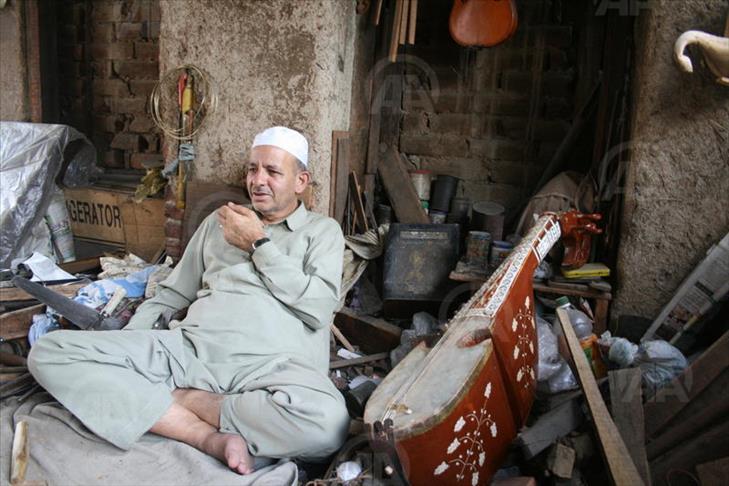
Light streams in through a small window, illuminating his aging face and withered fingers, which feel along the rough contours of an unfinished santoor.
For three centuries, in this very room, his ancestors have made Kashmir's best santoors and rababs, both of which are traditional stringed instruments.
Now, 74-year-old Ghulam Mohamed Zaz is the last in the line. After him, it is feared, this room – along with an entire tradition – will fall into obscurity.
"We have been making rababs and santoors for the last 300 years," Zaz, sitting in the room, told Anadolu Agency as he sharpened a chisel on an old stone.
"We made the first santoor in Kashmir," he boasted. "All the big artists of the valley played on our santoors."
Zaz represents the eighth generation of Kashmir's most famous and respected family of santoor and rabab makers.
For three centuries, his family provided the valley's most distinguished Sufiana musicians with their instruments.
While his family tried to forge perfect instruments on candlelight, Zaz spent many nights looking at them and learning the art that he is now the last master of.
"I was 15 when I made my first santoor," Zaz recalls. "I observed my father so keenly that I just picked up a piece of walnut wood and made a santoor."
"I would sit across from my father and grandfather and imitate them till I learned to make all the instruments they made. The future held such possibility then," Zaz remembers thinking.
The santoor, which means "a hundred strings" in Persian, came to Kashmir with the Persian invaders of the 15th century.
Various versions of the santoor exist in many parts of the world, differing mostly in terms of the number of strings.
"The Persian santoor now has 72 strings, the Chinese version has 45 and the German has 135," Zaz explains.
The Kashmiri santoor is a trapezoid-shaped hammered dulcimer, the hundred strings of which are struck with a pair of curved mallets known as mezrabs.
The santoor, along with the rabab, is an integral ingredient of Kashmiri folk and Sufi music.
-Dying art-
Islam came to the Himalayan valley of Kashmir in the 14th century, when Muslim preachers from central Asia arrived to spread the religion.
Over the centuries, music influenced by Sufism – known as "Kashmiri Sufiana mousique" – developed among the Muslim populace and became an important part of the local culture.
Over the years, as Sufiana music brought sound and beauty to the imperial courts and gatherings of the rich, the Zaz family had enjoyed the limelight.
"It was another time," he remembers proudly, "so different from today."
"Everyone respected us for the art we had," he recalls. "We were treated as artists and paid handsomely for our art."
Today, amid the changing times and fast-paced life inKashmir, Zaz feels left behind in his decaying shop, where customers remain rare and santoor connoisseurs even rarer.
He points around the room and ruminates on the old days, when his second-story shop – like his life – was brighter and offered more promise.
The walls of the room are now blackened from decades of fire used by the family to heat walnut wood into malleability.
"Today there is no money, only occasional words of acknowledgment," says Zaz. "And that's not enough to live on."
Zaz believes the world has forgotten him, leaving him among the unfinished rebabs, santoors and sarangis of a bygone age.
"Everyone is making money," he asserts. "They come here and take pictures and write about me, and they all make money. But I get nothing. I doubt if it is worth all the work now."
Zaz has three daughters, but no son to inherit the family's traditional vocation.
His daughters have never learnt the art and have always kept to their studies.
"I'm happy that no son of mine is into this art and that none of my children will have to suffer like I'm suffering," he says bitterly. "I'm proud that my daughters are part of the new world."
Sometimes, months will pass before Zaz sells a single rabab or santoor.
"Now much of my business depends on tourists and foreign customers," he notes.
In order to make ends meet, Zaz also repairs other stringed instruments, including sarangis and violins.
"It [the art of santoor manufacture] is dying a slow death with all the fast and loud music now taking center stage," he says.
When Zaz closes the old door of his workshop for the last time, there will be no one left to continue his family's legacy.
"The 100-string Kashmiri santoor is dying as quietly; and this art is dying in this room," he laments.
By Zahid Rafiq


